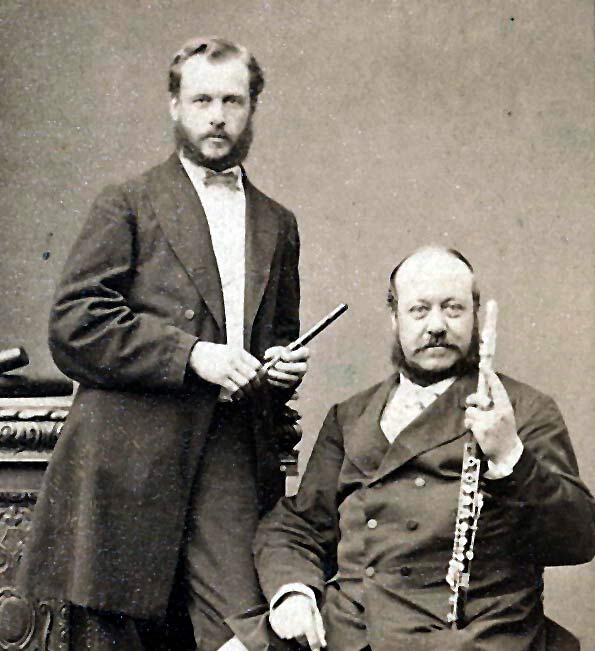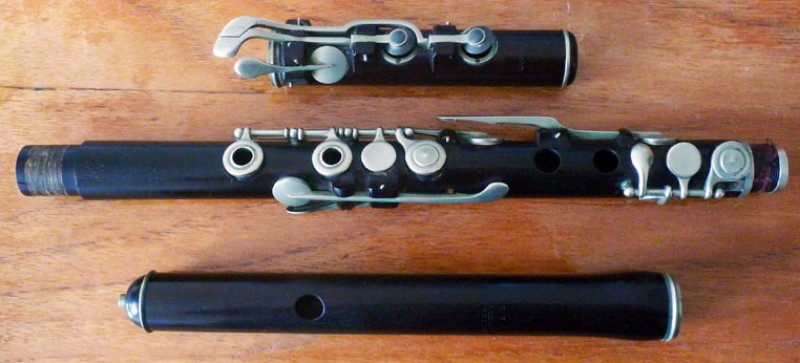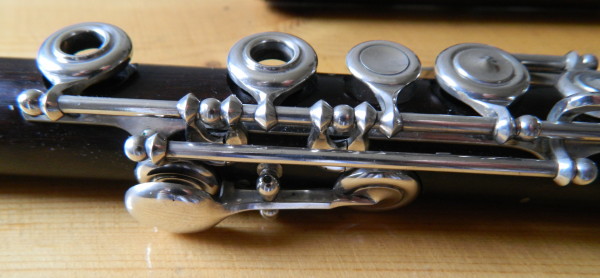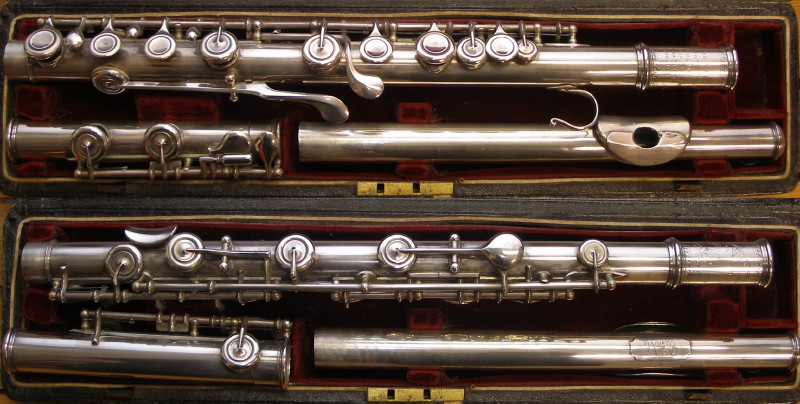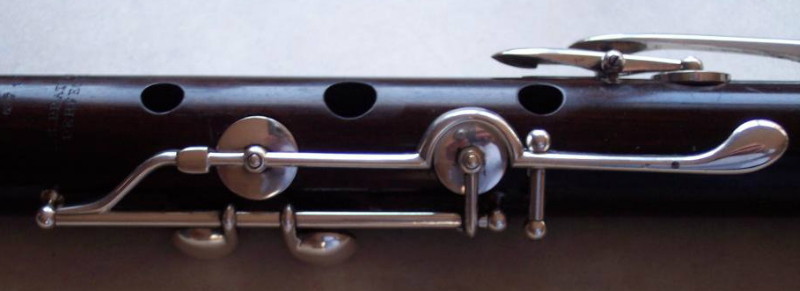|
Extant Pratten's Perfected Flutes
|
||||||||||||||||||||||||||||||||||||||||||||||||||||||||||||||||||||||||||||||||||||||||||||||||||||||||||||||||||||||||||||||||||||||||||||||||||||||||||||||||||||||||||||||||||||||||||||||||||||||||||||||||||||||||||||||||||||||||||||||||||||||||||||||||||||||||||||||||||||||||||||||||||||||||||||||||||||||||||||||||||||||||||||||||||||||||||||||||||||||||||||||||||||||||||||||||||||||||||||||||||||||||||
NotesEven with only this amount of data in, it appears that there is great uniformity in dimensions, and therefore probably in tuning, among Pratten's Perfected flutes, confirming the informal view generally held. After all, how many variations on perfect can we expect? But that's not to say there are not special versions out there somewhere. Only time and more data will tell. Dating information is taken from certificates in original cases, or from the workshop records as available. A question mark implies the date has been estimated, probably from the graph further up. A number of flutes exhibit certificate dates different from their workshop record dates. This suggests that the certificates were probably signed and dated in batches, rather than individually tested and approved by Mr Pratten as the certificate claims! It's starting to look like Boosey's dropped Pratten's floral initials (but not the full listing of his name) upon his death in 1868. Note also that the flute attributed to C. Boosé (4913) also is not initialled. 4646. Foot length is 143, Embouchure centre to end of body 87, compared to most others at around 132 & 96 respectively. This combination yields a similar sounding length, but must have implications for tuning. C#-D# length appears to be around 256mm, dramatically more than later instruments, and in the general range of Improved era flutes. 4675 has a (broken) LH thumb C-key plus upper D trill key, which might qualify it as being a 9 or 10-key, depending if you are counting pads or keys! We'll need to confirm how Boosey's naming policy worked. 7446 is so far the highest number reported as Boosey & Sons; 7676 lists Boosey & Co. My # 8626 is from Holles St, whereas 10161 is Regents St. We can probably narrow down that change of address as we go. No 11081 is so far the highest number Boosey & Co flute number titled Pratten's Perfected. No 19334 is a later Boosey & Co flute, not marked Pratten's Perfected. I'll mark such flutes in green. We'll look at the question of whether they are still Pratten's Perfected further down... Some examples of Conical Boosey PrattensI'm not going to show images of every Boosey Prattens still around, but I'll try to show unusual features. Which means if you think yours has noteworthy features that I haven't illustrated, send me an image! Here's a sight you (hopefully) won't see often - a Prattens fully dismembered...
and the same flute, #7109, under happier circumstances, some considerable time and dollars later...
As you can see, it features what we refer to as Hudson keys. You can see two of those keys with the cups unscrewed from their shafts near the centre of the upper image. One of the cups is shown screw-upwards below the shafts. The other is pad-upwards inside a ring on the right. A low-end Boosey PrattenThe instrument above represents the luxury class end of the Boosey 8-key range. My own Pratten, #8626, languishes at the other end of the market, with sterling silver replaced by nickel-silver, and posts by blocks. But probably still worth the $25 I spent on it back in the early 1970's! Add some bells and whistles...Here's the Royal College of Music London Prattens, No 4675...
In addition to the usual 8 keys, we can see:
Fully keyed Pratten
This flute No 7305 from the Bate Collection in Oxford. It seems to have the full count of 14 keys available in conical flutes. Note the mix of blocks, posts, and rod & axle keying. Remember, next time you are in England, visit the Bate! Boxwood and brass Pratten attributed to Carl Boosé
It seems that Boosey's were indulging in a little "badge engineering" - marketing the same instrument under more than one label. Booseys had acquired the Pratten's Perfected design from Hudson - it was normally made in cocus wood under their own name. But they clearly made it also in the cheaper boxwood and brass for military band use and marketed under the Boosé name (Rudall & Rose did precisely the same thing with the name Key). Roy Jones, who until recently had the flute, advises:
An interesting point is that it doesn't carry the RSP initials. The Ultimate in keyed Prattens?
This flute perhaps represents the ultimate development of the conical Pratten's Perfected. It adds a d trill, the twin thumb keys mentioned later, a Boehm-style foot, and has replaced the remaining block-mounted keys with rod & axle style. Mark: Boosey & Sons|24 Holles Street|London|6103|Pratten's Perfected This flute, and many many others, are sumptuously illustrated in Rudall, Rose & Carte : The art of the flute in Britain, Robert Bigio, London. Robert also advises that he has an original picture of
Pratten holding just such a flute, and concludes that it probably safe
to say that this is what Pratten played on. That picture, complete with
a ghost image of a Yorkshire terrier in the bottom right-hand corner, is
in Robert's previous book Readings in the History of the Flute,
(p106). See http://www.robertbigio.com/ for details of his books and more. There is another image that appears to show this flute in the hands of Pratten:
Richard Shepherd Rockstro, piccolo
(left) with Robert Sidney Pratten, flute. Extant Military Band flutes by Boosey & CoIt might come as a surprise to find that there were military band flutes made by Boosey marked Pratten's Perfected, but the evidence is clear. Boosey's period catalogues confirm the same.
Pratten Flute in F, image courtesy Stephen Pratt The serial no. is 9448. Sounding length 47cm; C# to D# is 21cm; it has 8 nickel block mounted silver keys. Boosey Pratten band flutes found so far:
Those in Green are not marked Pratten's Perfected, probably coming too late for that stamp. Owner's comments (thanks Dave!):Circa 1880 Boosey & Co. Pratten’s Perfected 4 key B flat fife in boxwood, serial #10956. Stamped Boosey & Co., / 295 Regent Street / London / 10956 / R.S. Pratten’s Perfected on the body. Nice figured boxwood, substantial, well made brass keys and rings, crack repair to head. Original embouchure, plays very well. Inside the fife was a note on the letterhead of Hotel Nova Scotian: “Fifes that belonged to John Palmer Daniels b. near Windsor, became a watchmaker & jeweller, d. Sackville, N.B. late 1897.” Ca. 1885 Boosey & Co. ebonite 8 key flute in F, serial #12586. Nickel Silver post mounted key work, C & C# keys are pewter plugs. Stamped Boosey & Co. / 295 Regent Street / London / 12586 on the body, Boosey & Co. / London / 12586 on the barrel and on the foot joint. No cracks (made of ebonite, an early compound of rubber and other materials, also used for smoking pipe bits), original embouchure, original leather case. Excellent original condition, plays great. Ca. 1906 Boosey & Co. cocuswood 6 key flute in F, serial # 17349. This is an interesting Boosey flute, no doubt made for flute band work. The body is single piece, no separate foot. The head has a tuning slide, and is the only detachable part. Nicely made nickel silver keywork and rings, complete with end cap, and all rings and keys. It’s stamped Boosey & Co. / London / 17349 on the body. Crack to back of head joint, needs cleanup and pads. No case. Ca. 1920 Boosey & Co. cocuswood 8 key flute in Eb, serial #21057. Stamped on the body Boosey & Co. / Makers / London / 21057 / Guaranteed / British Made / Throughout, and on the barrel and foot Boosey & Co. / 21057. Pratten style with Boehm style foot keys. Repaired cracks to head and barrel, repairs to foot keys (now difficult to detect). A great playing Eb Boosey in the Pratten style. Very nice overall condition. Plastic hard case. Extant Cylindrical Pratten's Perfected by Boosey & CoWhile we are traditionally attracted more to the 19th century conical flutes, we see from the figures above that a reasonable proportion of the flutes that Boosey's made were cylindrical.
Notes9328 - head and barrel may not be original, possibly distorting the speaking length value. 10604 - an all-metal Pratten's Perfected 12209 is arguably not a Pratten's Perfected - it doesn't carry the name - but it was made by Boosey & Co. I'll colour Boosey flutes not stamped Prattens green. I estimate from the graph above that it was made around 1882, quite some time after Pratten's untimely death in 1868. Perhaps enough time had elapsed for the Pratten name's magic to evaporate? Certainly, we could hardly expect Pratten to keep popping into the Boosey showroom to sign the acceptance certificates! We'll look at this question further down. Note also the significantly longer C#-D# length when compared to #9328, suggesting a lower pitch, while the sounding length is shorter suggesting a higher pitch. Hmmm. Some more data might help us understand what's going on there. 17007, Horniman Collection notes: Flute, Pratten model [but not marked as such - Terry], low pitch. Model number A171. Serial number 17007. Cocuswood with German silver keys, mounts and ferules. Head and body joint are also metal lined. Cylindrical bore. Eight keys. Two rings and cover-plate for left hand; cover-plate for right hand and two large covered holes. Body in one piece. In fitted wooden case with cleaning rod and grease-box. Date made, 1904 (presumably taken from the workshop records which are held by the Horniman). This flute appears the same as #9740, pictured below. Some Cylindrical Pratten ImagesAlthough the numbers suggest that not so many cylindrical Prattens were made, they certainly show some variety, as you'll see ... No 7213
For sale on Ebay, Jan 2013. Image courtesy of demisemiquaver. No 7900
At the Germanisches Nationalmuseum, Nürnberg. Note the similarity between the head of this instrument and the head on the flute Pratten is holding. While the body of Pratten's flute looks more like #9328 below.... No. 9328
The owner, Stephen Pratt advises:
Improved Siccama style
No 9740 - a largely-keyed cylindrical offered on Ebay
by On an historical note, Arthur advises that the flute was in the possession of the player and fettler Paul Davies when he died and is the last of the flutes still owned by Paul's widow. Gofer Joe's Metal PrattenJoseph Wilds Sallenger (a.k.a Gofer Joe) is Manager of Fine Arts, Programs & Facilities at Francis Marion University and a self-confessed Certified Flute Nut (see link for proof). One of Joe's many interesting acquisitions is this very rare all-silver cylindrical Pratten's Perfected.
Joe says of the flute, Boosey No.10604:
Thanks, Joe for upgrading the image, just for us! More images of Joe's flutes at: http://goferjoe.bygones.biz/boosey.htm Details of Pratten's flutesUnder this heading we'll draw your attention to some unusual or important details of some Pratten's Perfected flutes... Pratten's C and Bb keyThe upper C note was always at a disadvantage in simple system flutes. Cross fingered C was noticeable weaker than adjacent notes. The R1 c-key was great for trills, but inconvenient in a run such as B-c-d. Boehm gave it a L thumb key in his 1832 conical and 1847 cylindrical designs, Clinton came up with a number of ideas for combined Bb/C keys, Carte employed two adjacent thumb touches and Briccialdi cooked up the version we see today on the modern Boehm. So perhaps not surprising that Pratten felt the need to go the same way. Reference to it even found its way into his fingering chart. The image below, kindly supplied by Bob Midden, comes from his cylindrical Boosey flute, but the same C key was also fitted to conicals. I must admit, when I first encountered it, I was quite nonplussed. Where do you put your thumb when not playing either key?! How do you hold the flute up without the thumb? But that was before I'd adopted the three-point flute hold used in those days. The simple answer is that the left thumb should hover free in space, ready to pounce upon whichever key is needed. The benefit of the three-point hold is not limited to freedom of the left thumb and R4 to operate their keys, but also to the flexibility of the right hand fingers, and general stability of the flute. There are several accounts of how to achieve this on this website, but a good one to start with is Nicholson's.
Many more lovely photos of Bob's flute at http://midden.zenfolio.com/p796148841 And here are the same two keys, approached from a rod & axle perspective
Note also the use of Hudson-style unscrewable key cups. Note also the lack of the customary guide on the upper shaft of the C key. The socket which lifts the key when the L thumb-key is pressed presumably provides the lateral guidance the key needs to seat reliably. More to comeI'll bring you more images of Pratten flutes and unusual features as time and opportunity permits. Boosey, but not Prattens?Finding that later Boosey & Co flutes are not marked R.S.Pratten's Perfected naturally raises the question, are they still Pratten's Perfecteds, or has the design changed too significantly? We'll obviously be watching for evidence of this; early indications with the limited data we are collecting seems to suggest they have not changed. Of course some tinkering may be expected as British High Pitch collapses around 1895, replaced by something approximating modern pitch. So the question is perhaps one for us - would we accept minor updating as still within the spirit of Prattens, if the most part of the instrument remains the same? There are clues elsewhere of how Boosey's regarded it.
I have a copy of a Boosey & Co catalogue from circa 1900 that describes
all their flutes (including cone and cylinder flutes, and the military
types) as R.S.Pratten's Perfected models. Another catalog, circa
1923 continues in the same light, although it also shows "a new model
cylinder, covered holes". The engravings in the catalogue shows
the makers mark as Boosey & Co / Makers / 25 Regent St / <serial
number>. The serial number on the 8-key cone appears to be 18899,
which should place it around 1908. They offer two versions of the
8-key, Model 165, presumably with traditional foot, and Model No 167
"with superior foot", ie Boehm foot. So, even with this clear
change, Boosey's still saw it and promoted it as a Prattens, even though
they didn't mark it as such.
|
AcknowledgementsThanks to all those people and institutions who have provided data or images or allowed me to measure their instruments.
|
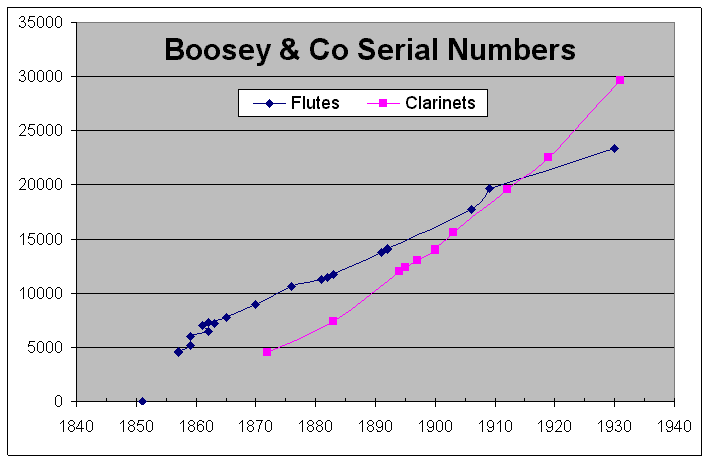
.jpg)
.jpg)
.jpg)
.jpg)
.jpg)
.jpg)
